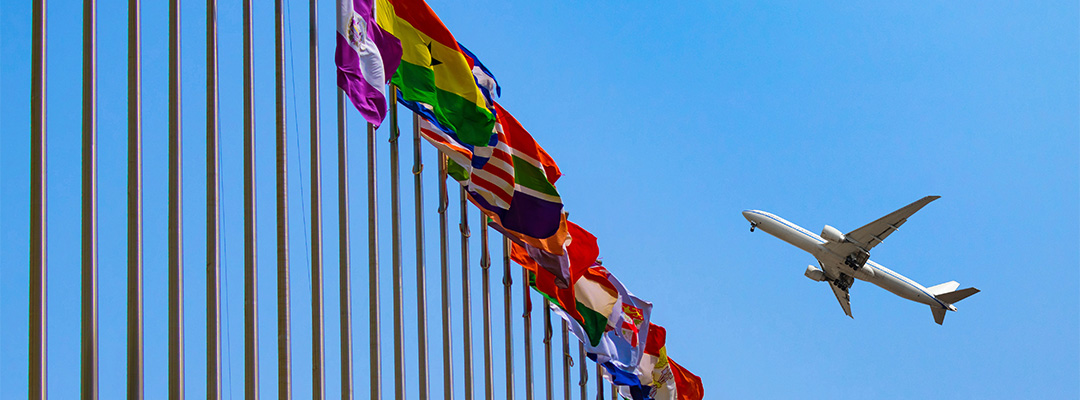Grow your business with the Discover newsletter
Logistics advice & insights straight to your inbox
Subscribe now
Whilst the benefits of globalization are typically equated with cross-border trade, the DHL Global Connectedness Report 2024 takes a broader view, drawing on nearly 9 million data points to provide a comprehensive portrait of international flows of capital, information and people, too. It measures not just the size of these flows, but which other countries each country interacts with – making it a unique index in terms of both size and its scope of geographic patterns.
Firstly, the flow of trade – how much a country exports and imports goods and services and how broadly a country’s trade is spread around the world. Secondly, the flow of capital, meaning the investment that goes in and out of a country. Thirdly, the flow of information between a country and others, such as online news traffic, scientific research collaboration, and international internet bandwidth. And finally, the flow of people, including the level and geographic reach of a country’s international travel and migration.
With a detailed ranking and analyses of 181 countries, the DHL Global Connectedness Report has unrivalled insights into global trade trends, making it a must read for any business with international growth ambitions.
Dani Rodrik, Ford Foundation Professor of International Political Economy at Harvard’s John F. Kennedy School of Government
The world has endured several shocks over the past decade, including the war in Ukraine, and the Covid-19 pandemic, which disrupted global supply chains to an extent never seen before. Naturally, these events prompted much analysis about the challenges of globalization. Yet, in defiance of such expectations, global connectedness reached a record high in 2022, and remained close to that level in 2023.
Despite a population of just 5.6 million1, Singapore’s low taxes, excellent infrastructure, strong banking sectors, and almost entirely urban population have helped make it one of the world’s most advanced economies, whilst its major port operations means it’s uniquely positioned to excel in globalization. Today it enjoys the title of the world’s most connected country.
Relations between the superpowers are stabilized but precarious. Rising tensions led to the two countries pulling back from direct trade with each other in 2023. There are also recent declines in the shares of capital, information and people flows crossing between the US and China. Yet, they still show no real decoupling – they remain connected by larger flows than almost every other pair of countries.

Over the last couple of years, Russia’s trade has shifted away from Western-aligned countries, and foreign investment into the country has collapsed. Perhaps unsurprisingly, in 2022, it had the largest single-year drop in global connectedness on record for a major economy – proof, if needed, of the detrimental impact of severing cross-border trade flows.
Rising tensions between the US and China have prompted fears that a new cold war could fracture the global economy into rival blocs. Yet, the share of trade happening between US-aligned and China aligned-blocs (excluding Russia) is now roughly back to its pre-pandemic level.
Despite geopolitical tensions and concerns about supply chain resilience, globalization has not given way to regionalization. Most international flows are taking place over stable or longer distances, bolstered by the growth of emerging economies. Focusing on trade, only North America shows a clear nearshoring trend.
Steven A. Altman, Senior Research Scholar and Director of the DHL Initiative on Globalization, NYU Stern
Global flows are being driven by businesses investing heavily in international expansion projects – the value of which is at its highest level relative to world GDP in more than a decade. The cross-border share of mergers and acquisitions is holding steady, too.
The Covid-19 pandemic drove the share of trade in global economic output to a record high in 2022. But in 2023, slowing macroeconomic growth on the heels of large interest rate increases in many countries led to a modest pullback in global trade intensity. 2024’s forecast looks bright: trade growth is expected to accelerate to a slightly faster pace than GDP growth.
Over the past two decades, information flows have reached the highest level of globalization compared to the other three flow types. Yet, the trend stalled in 2022 and 2023, suggesting geopolitical tensions and policy restrictions on data flows may be starting to have a meaningful impact.
Domestic flows still far exceed international flows, and the world’s current depth of global connectedness is only 25% – on a scale from 0% (no flows cross national borders) to 100% (borders and distance no longer matter at all).
Ngozi Okonjo-Iweala, Director General of the World Trade Organization
Since the last edition of this report was released a year ago, some of the challenges of globalization have eased while others have intensified, leading to conflicting forecasts for the future. But the DHL Global Connectedness Report goes beyond the headlines to examine the cold, hard data on the real state of globalization.
Discover insights about emerging markets and global trade growth to empower your cross-border trading decisions with the DHL Global Connectedness Report. Who knows where it could take your business…